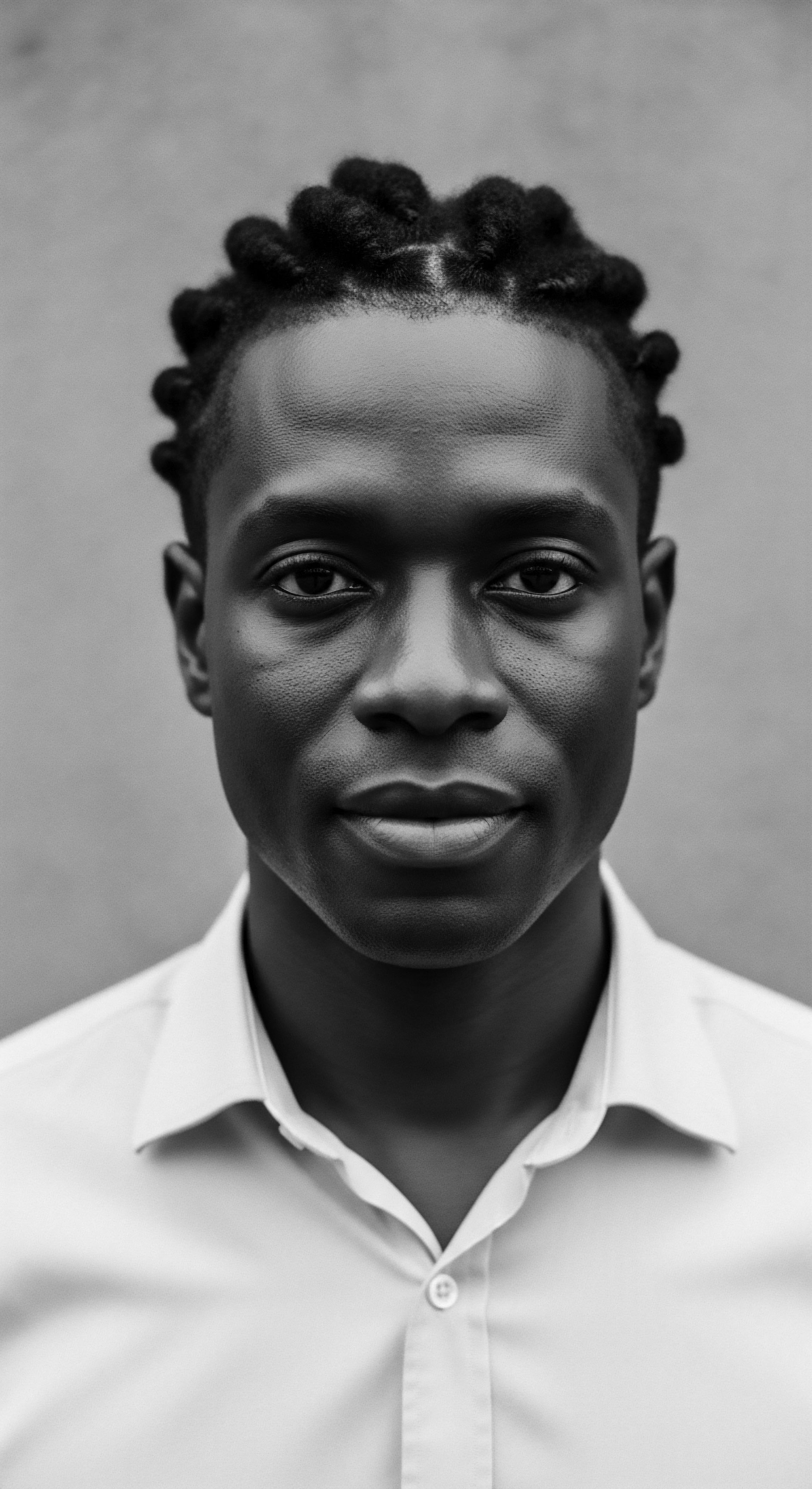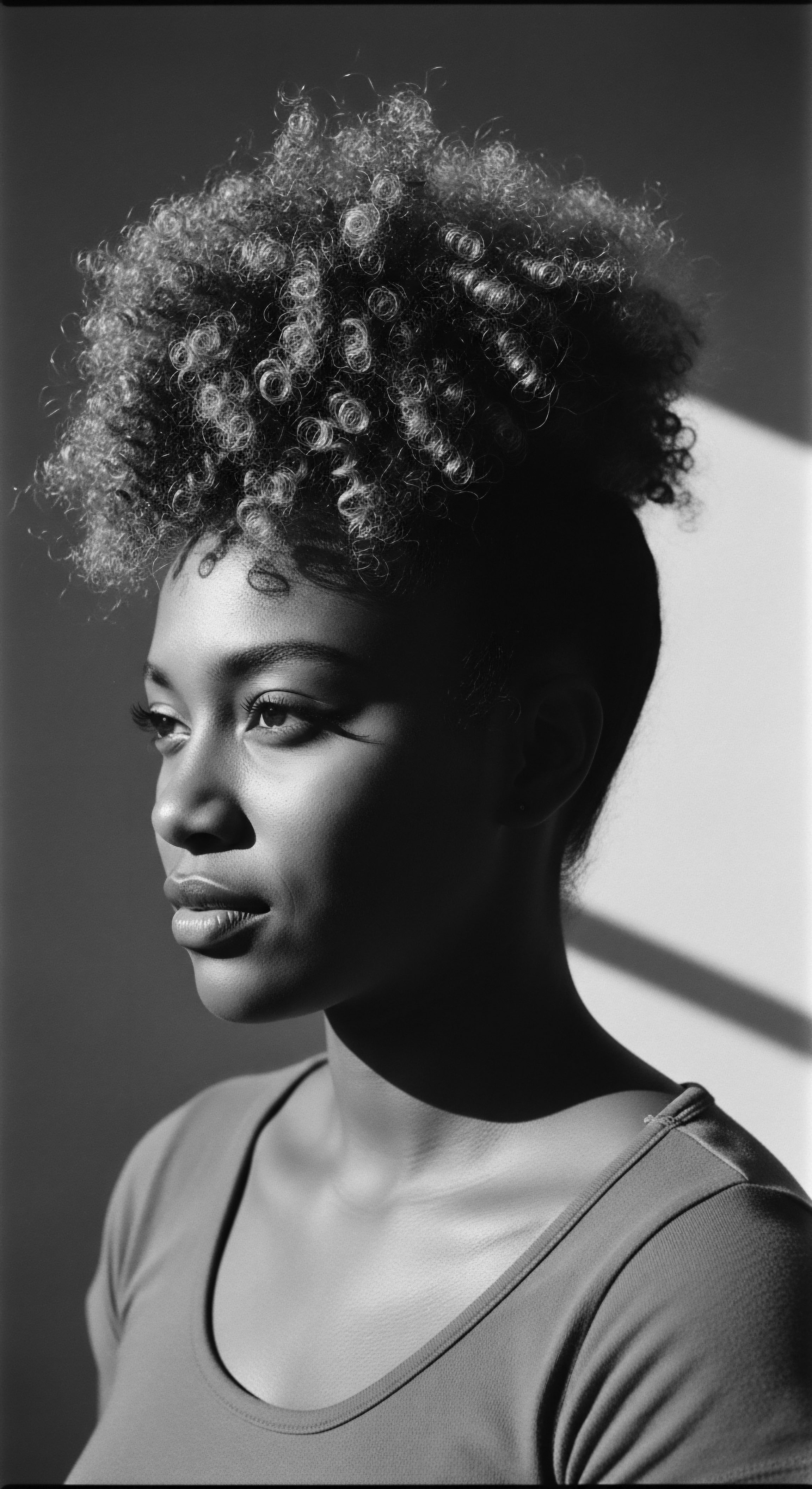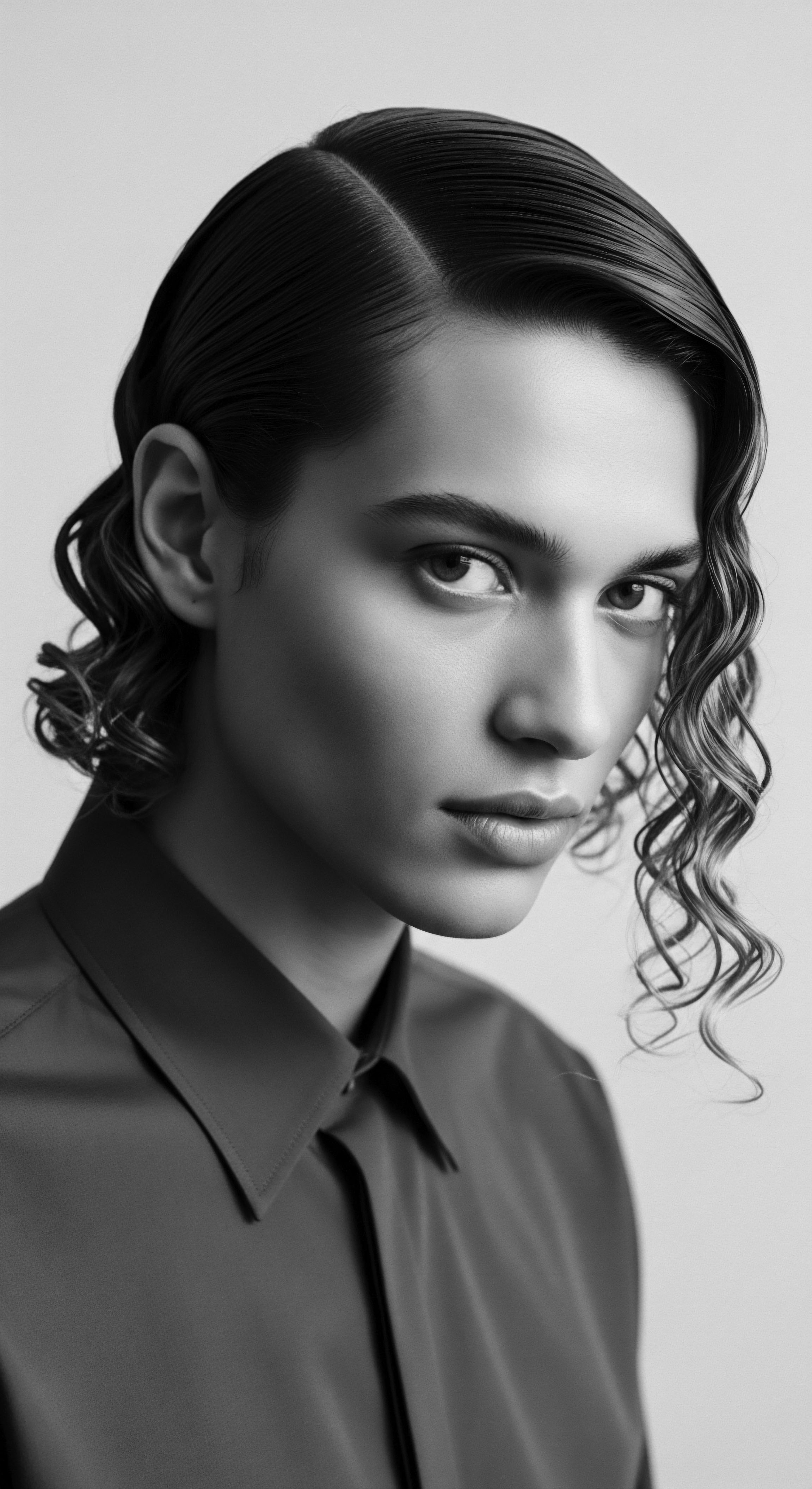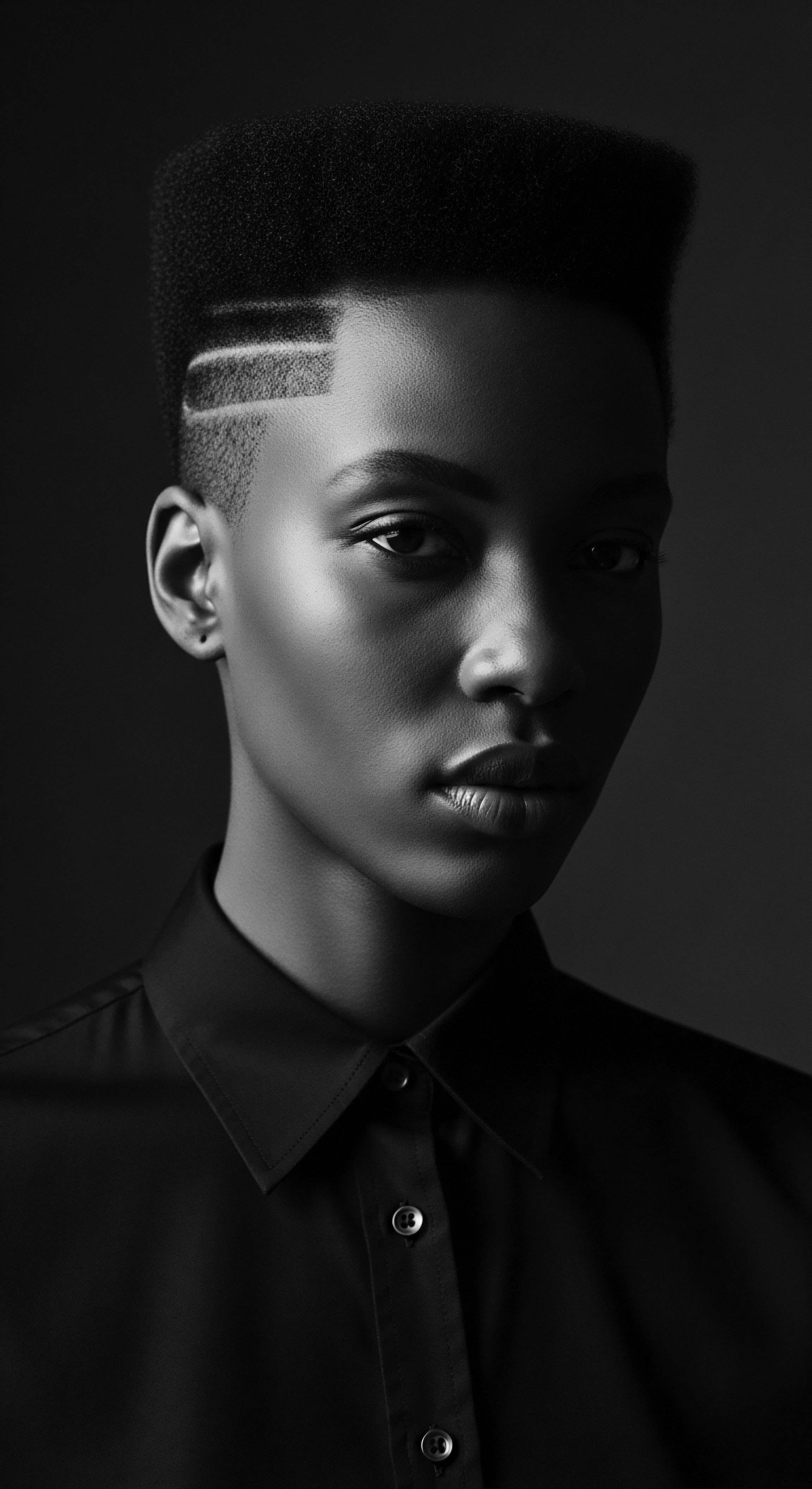
Fundamentals
The concept of Textured Hair Damage, at its most elemental, speaks to any alteration in the physical integrity or chemical composition of textured hair strands, causing a deviation from their healthy, inherent state. This includes a spectrum of manifestations, from the subtle loss of natural sheen to overt breakage and thinning. It is a fundamental understanding that all hair, irrespective of its unique curl pattern or density, possesses a delicate structure, susceptible to external forces and internal imbalances. For textured hair, particularly that of Black and mixed-race heritage, this susceptibility is often amplified by its distinct helical shape and the historical context of its care.
The Meaning of Textured Hair Damage extends beyond mere aesthetics; it signals a disruption in the hair’s natural resilience, its capacity to retain moisture, and its ability to withstand environmental stressors. Think of a healthy strand as a finely spun cord, robust yet pliable. When damage occurs, this cord frays, weakens, or loses its inherent elasticity.
This can stem from a myriad of sources ❉ excessive manipulation, harsh chemical treatments, or even environmental aggressors like sun and wind. The explanation for such damage often lies in the disruption of the hair’s cuticle layer, the outermost protective sheath, or the weakening of its internal protein bonds.
Understanding Textured Hair Damage, then, becomes a crucial step in nurturing these strands back to their ancestral strength. It is not merely about identifying a problem; it is about recognizing the signals the hair sends when its well-being is compromised. This initial awareness, though simple, lays the groundwork for a more profound connection to one’s hair and its storied past.

Recognizing the Early Whispers of Damage
Before significant harm becomes visible, textured hair often offers subtle indications of distress. These early whispers might be a slight increase in shedding during detangling, a feeling of dryness even after moisturizing, or a diminished bounce in the curl pattern.
- Dryness ❉ A persistent lack of moisture, even with regular hydration, can signal a compromised cuticle layer, allowing water to escape too readily.
- Loss of Elasticity ❉ Healthy hair possesses a certain spring; if strands snap rather than stretch when gently pulled, it suggests weakened protein bonds.
- Increased Tangling ❉ When the cuticle is raised or damaged, hair strands can snag on one another more easily, leading to persistent tangles and knots.

Common Culprits in Hair Distress
The causes of Textured Hair Damage are diverse, yet many are linked to practices that have, at times, been intertwined with societal pressures and historical beauty standards.
Textured Hair Damage is a deviation from the hair’s natural, healthy state, often signaling a compromise in its structural integrity and inherent resilience.
Consider the pervasive influence of heat styling, a practice that, while offering temporary straightness, can exact a heavy toll. The application of intense heat from flat irons or hot combs can cause what is known as “bubble hair,” where water within the hair shaft boils, creating air pockets that weaken the strand from within. This physical alteration is a clear manifestation of damage, a direct consequence of disrupting the hair’s natural moisture balance.

Intermediate
Moving beyond the foundational understanding, the intermediate interpretation of Textured Hair Damage delves into the specific biological and historical factors that render textured hair particularly susceptible. This explanation acknowledges the unique architecture of coiled and curly strands, where the cuticle layers are often less tightly packed and the hair shaft itself can be more elliptical, creating points of vulnerability. The meaning here expands to encompass not just physical damage, but also the systemic impacts of historical beauty norms on hair health.
Historically, the journey of textured hair has been fraught with challenges, often dictated by external pressures to conform to Eurocentric beauty ideals. The pervasive use of chemical relaxers, for instance, represents a profound intersection of cultural assimilation and physical compromise. These potent chemical formulations work by breaking down the hair’s disulfide bonds, fundamentally altering its natural curl pattern.
While offering the illusion of “manageability” or “professionalism,” this process inherently weakens the hair, leaving it prone to breakage, dryness, and scalp irritation. The explication of Textured Hair Damage at this level necessitates an examination of such practices, recognizing their origins not in a lack of care, but often in a desperate bid for acceptance within a society that devalued natural textured hair.

The Delicate Architecture of Textured Strands
The inherent structure of textured hair contributes to its unique needs and, at times, its vulnerability. Unlike straight hair, which tends to be round in cross-section, textured hair can be oval or even ribbon-like, creating areas where the cuticle is naturally lifted or less uniform.
- Cuticle Integrity ❉ The outermost layer, the cuticle, acts as a protective shield. When these scales are lifted or chipped, the hair’s inner cortex is exposed, leading to moisture loss and increased friction.
- Moisture Retention ❉ The twists and turns of coiled hair make it more challenging for natural oils from the scalp to travel down the entire length of the strand, contributing to dryness and making it more prone to damage.
- Fragility at Bends ❉ Each bend in a curl pattern represents a point of structural weakness, where the hair is more susceptible to snapping under stress from styling or manipulation.

Echoes of History ❉ Chemical Alterations and Their Legacy
The story of textured hair damage cannot be fully told without acknowledging the historical context of chemical straightening. For generations, products designed to alter the natural curl pattern were marketed heavily to Black women, promising a path to societal acceptance.
The intermediate meaning of Textured Hair Damage unveils its intricate connection to the unique structural biology of coiled strands and the profound historical pressures that shaped care practices within Black and mixed-race communities.
Consider the widespread adoption of chemical relaxers, a practice that gained significant traction in the 20th century. These products, often containing highly alkaline chemicals, chemically disrupt the hair’s disulfide bonds, permanently altering its structure. This process, while achieving a straightened look, fundamentally compromises the hair’s strength, leaving it susceptible to breakage, dryness, and irritation. Dr.
Amy McMichael, a Dermatology Professor at Wake Forest, notes that repeated application to new growth often overlaps with previously treated hair, leading to compounding damage. A study published by Boston University’s Black Women’s Health Study (BWHS) reported that postmenopausal Black women who used chemical hair relaxers more than twice a year or for over five years had a greater than 50% increased risk of uterine cancer (Bertrand et al. 2023). This alarming statistic highlights the profound health consequences tied to historical beauty standards and the products used to achieve them.
This historical reality underscores how Textured Hair Damage is not merely a cosmetic issue, but a profound reflection of systemic pressures and the enduring resilience of communities striving to define beauty on their own terms.

Academic
The academic definition and meaning of Textured Hair Damage transcends superficial observations, delving into a comprehensive explication rooted in trichological science, cultural anthropology, and historical sociology. This interpretation positions Textured Hair Damage not merely as a physical ailment, but as a complex phenomenon intricately woven into the socio-cultural fabric of Black and mixed-race identities, a legacy of historical marginalization, and a contemporary challenge demanding culturally attuned scientific inquiry. The clarification of this term requires a rigorous examination of the unique biomechanical properties of highly coiled hair, the historical imposition of Eurocentric beauty standards, and the subsequent widespread adoption of damaging practices, often driven by external pressures rather than inherent hair health.
The delineation of Textured Hair Damage at this advanced level acknowledges that the helical structure of Afro-textured hair, characterized by its elliptical cross-section and fewer cuticle layers at points of curvature, inherently presents a higher propensity for mechanical stress and moisture loss compared to straight hair. This inherent structural specification means that even seemingly benign external forces, such as vigorous detangling or environmental desiccation, can exert disproportionate strain, leading to premature fracture of the hair shaft. The statement of its significance is further amplified by the historical context of hair as a profound marker of identity, status, and spiritual connection within diverse African societies, a heritage brutally disrupted during the transatlantic slave trade when hair was forcibly shorn, a deliberate act of cultural erasure and dehumanization. This historical trauma established a long shadow, where the natural state of textured hair was often stigmatized, leading to the adoption of practices designed to alter its intrinsic form.

The Biomechanics of Vulnerability and Resilience
The intricate architecture of textured hair strands, from their follicular origin to their terminal tips, dictates a distinct biomechanical profile. Unlike the typically circular cross-section of straight hair, highly coiled strands exhibit an elliptical or flattened shape, with an uneven distribution of cortical cells and a cuticle layer that does not lie as flatly, particularly at the numerous bends and twists. This structural morphology contributes to several inherent characteristics:
- Increased Friction ❉ The raised cuticle scales and irregular surface of coiled hair increase inter-fiber friction, leading to tangling and knotting, which in turn necessitates more rigorous detangling, a common source of mechanical damage.
- Reduced Moisture Retention ❉ The lifted cuticle also facilitates a more rapid escape of internal moisture, rendering textured hair inherently drier and more susceptible to brittleness and breakage, particularly at the apex of its curls.
- Differential Stress Distribution ❉ Each helical turn in a coiled strand acts as a point of concentrated stress during manipulation, making these areas highly vulnerable to fracture under tension or repeated bending.
These intrinsic properties mean that Textured Hair Damage, whether manifesting as trichorrhexis nodosa (nodular swellings and fractures along the shaft), split ends (trichoptilosis), or cuticle erosion, often represents a complex interplay between inherent structural predispositions and external stressors.

A Heritage Under Siege ❉ The Imposition of Eurocentric Standards
The history of textured hair in the diaspora is inextricably linked to the socio-political landscapes shaped by slavery and colonialism, which systematically devalued African aesthetics and imposed Eurocentric beauty standards. This cultural imposition led to a widespread societal pressure, particularly for Black women, to chemically or thermally straighten their hair to attain “acceptable” appearances for professional and social integration.
The academic meaning of Textured Hair Damage reveals a complex interplay of unique hair biomechanics, historical cultural pressures, and the lasting impact of practices rooted in a devaluing of ancestral aesthetics.
The introduction and proliferation of chemical relaxers and hot combs in the late 19th and early 20th centuries offered a seemingly expedient path to conformity, yet at a significant biological and psychological cost. These practices, while achieving temporary textural alteration, inflicted profound damage. Chemical relaxers, for instance, employ strong alkaline agents (such as sodium hydroxide or guanidine hydroxide) to permanently disrupt the hair’s disulfide bonds, thereby reducing its natural curl. This process irrevocably weakens the hair’s tensile strength, making it brittle and highly prone to breakage.
A powerful case study illuminating this connection is the pervasive use of chemical relaxers among Black women in the United States. Studies indicate that up to 95% of adult Black women in the U.S. have reported using hair relaxers at some point in their lives, often initiating use at early ages. The Boston University Black Women’s Health Study (BWHS) found that postmenopausal Black women who reported using hair relaxers more than twice a year or for more than five years had a greater than 50% increased risk of uterine cancer compared to those who never or rarely used them (Bertrand et al.
2023). This statistic, beyond its alarming health implications, serves as a stark testament to the profound and often unseen costs of conforming to beauty standards that denied the intrinsic beauty of textured hair. It highlights how the historical trauma of devaluing Black hair translated into practices that not only caused physical damage to the hair itself but also contributed to significant health disparities within the community.
The enduring societal pressures to straighten hair, often to secure employment or avoid discrimination, created a cycle where the very tools of assimilation became agents of damage. The meaning of Textured Hair Damage, therefore, is inseparable from this historical narrative, reflecting generations of resilience, adaptation, and the eventual reclamation of ancestral hair forms through movements like the natural hair resurgence.

Ancestral Wisdom and Modern Science ❉ A Confluence of Care
The understanding of Textured Hair Damage is deepened by examining historical and ancestral hair care practices, which often prioritized moisture, protection, and gentle manipulation—principles now validated by contemporary hair science. Many African cultures possessed sophisticated hair care rituals, viewing hair not merely as an adornment, but as a spiritual conduit, a symbol of identity, and a repository of wisdom.
The deeper understanding of Textured Hair Damage underscores the enduring legacy of historical pressures on Black hair health and the profound wisdom embedded in ancestral care practices.
These traditions, passed down through generations, often incorporated natural ingredients and protective styling methods that intuitively addressed the unique needs of textured hair.
| Aspect of Care Moisture Retention |
| Ancestral Practices (Echoes from the Source) Application of natural butters like shea butter and oils such as marula oil, often mixed with clays, to seal in moisture and protect from environmental elements. The Himba tribe, for instance, uses a paste of ochre and animal fat. |
| Modern Scientific Understanding (The Unbound Helix) Emphasizes humectants (glycerin, hyaluronic acid) and occlusives (natural oils, silicones) to draw and seal moisture into the hair shaft. Recognizes the low porosity of some textured hair types, necessitating specific layering techniques like LOC/LCO methods. |
| Aspect of Care Gentle Detangling |
| Ancestral Practices (Echoes from the Source) Finger detangling or use of wide-toothed combs crafted from natural materials, often performed on damp, lubricated hair during communal grooming rituals. |
| Modern Scientific Understanding (The Unbound Helix) Advocates for detangling on wet or damp hair with ample conditioner or detangling agents, using wide-tooth combs or fingers to minimize mechanical stress and breakage. |
| Aspect of Care Protective Styling |
| Ancestral Practices (Echoes from the Source) Intricate braiding, twisting, and wrapping techniques (e.g. cornrows, Bantu knots, hair wraps) to minimize manipulation and exposure to harsh elements, signifying social status and cultural identity. |
| Modern Scientific Understanding (The Unbound Helix) Recommends styles like braids, twists, and buns to reduce daily manipulation, prevent friction, and protect hair ends from environmental damage. Emphasizes loose styling to avoid traction alopecia. |
| Aspect of Care Scalp Health |
| Ancestral Practices (Echoes from the Source) Use of herbal infusions and clays for cleansing and soothing the scalp, recognizing its role in healthy hair growth. |
| Modern Scientific Understanding (The Unbound Helix) Focuses on balanced cleansing to prevent product buildup and maintain scalp microbiome, with targeted treatments for conditions like seborrheic dermatitis, recognizing the scalp as the foundation for healthy hair. |
| Aspect of Care These parallel insights demonstrate a continuous, evolving wisdom in textured hair care, bridging ancient practices with contemporary scientific understanding. |
The current natural hair movement, a powerful contemporary manifestation of this heritage, represents a deliberate return to these ancestral principles, rejecting historical pressures to conform and instead celebrating the inherent beauty and resilience of natural textured hair. This movement actively reclaims practices that prevent damage by honoring the hair’s natural state, often using techniques and ingredients that echo the wisdom of generations past.

The Unbound Helix ❉ Shaping Futures Through Knowledge
The ongoing exploration of Textured Hair Damage, viewed through the lens of heritage, holds profound implications for shaping the future of hair care, identity, and wellness. It demands a critical re-evaluation of product formulations, a dismantling of discriminatory beauty standards, and an affirmation of the intrinsic value of textured hair in all its forms.
This future vision involves not merely treating the symptoms of damage, but addressing its root causes, both biological and societal. It calls for:
- Culturally Competent Research ❉ Further scientific inquiry specifically tailored to the unique characteristics of textured hair, moving beyond generalized hair science to address specific vulnerabilities and optimal care strategies.
- Ethical Product Development ❉ The creation of hair care products that are genuinely nourishing and protective, free from harmful chemicals, and formulated with the specific needs of textured hair in mind, often drawing inspiration from ancestral ingredients and practices.
- Advocacy and Education ❉ Continued efforts to combat hair discrimination (such as the CROWN Act) and to educate broader society about the beauty, versatility, and historical significance of textured hair, fostering an environment where natural hair is universally celebrated and respected.
The deep understanding of Textured Hair Damage, therefore, is not a static definition, but a living narrative, continually informed by scientific discovery, historical reflection, and the ongoing journey of self-acceptance and cultural affirmation within Black and mixed-race communities. It represents a call to action, urging us to honor the heritage of textured hair by protecting its health and celebrating its enduring spirit.

Reflection on the Heritage of Textured Hair Damage
The story of Textured Hair Damage, when truly contemplated, becomes a profound meditation on the journey of a strand, a journey deeply intertwined with the soul of a people. It is not merely a clinical description of broken bonds or frayed cuticles; it is a resonant echo of historical pressures, a silent testament to resilience, and a vibrant declaration of self-acceptance. Our exploration has traversed from the elemental biology of the helix, revealing its inherent delicate nature, to the living traditions of care passed down through generations, and finally, to the powerful assertion of identity that textured hair represents today.
The damage experienced by textured hair often speaks of a past where its very form was deemed “unruly” or “unprofessional,” compelling individuals to adopt practices that compromised its vitality. This historical narrative, particularly for Black and mixed-race communities, has imbued Textured Hair Damage with a significance that transcends the purely physical. It becomes a symbol of the silent battles fought for self-expression and cultural validation.
Yet, within this narrative of struggle, there is an equally potent story of enduring wisdom. The ancestral practices of cleansing with natural clays, moisturizing with rich butters, and protecting with intricate braids were not simply aesthetic choices; they were profound acts of care, deeply rooted in an intuitive understanding of the hair’s needs, long before modern science could offer its validations.
Textured Hair Damage is a living narrative, reflecting historical pressures, embodying ancestral resilience, and shaping the future of hair care and identity.
To understand Textured Hair Damage, then, is to walk alongside the ancestors, to hear the whispers of ancient rituals, and to recognize the profound connection between a strand of hair and the spirit it adorns. It is an invitation to heal, not just the physical strand, but the historical wounds, to celebrate the beauty of every coil and kink, and to step into a future where the health and heritage of textured hair are honored as one. This living library, Roothea, seeks to illuminate these truths, fostering a deeper reverence for the intricate, beautiful journey of textured hair.

References
- Bertrand, K. A. et al. (2023). First Large Study of Hair Relaxers Among Black Women Finds Increased Risk of Uterine Cancer. Boston University.
- Byrd, A. D. & Tharps, L. D. (2001). Hair Story ❉ Untangling the Roots of Black Hair in America. St. Martin’s Press.
- Da Costa, D. (2021). History of the Natural Texture Hair Movement .
- Dermatology, A. (2022). Afro-Ethnic Hairstyling Trends, Risks, and Recommendations. MDPI .
- DermNet. (n.d.). Hair care practices in women of African descent.
- Elle. (2020). A Brief History Of Black Hair Rituals.
- Health Matters – NewYork-Presbyterian. (2024). What to Know About the Connection Between Hair Relaxers and Uterine Cancer.
- James-Todd, T. (2024). Uncovering the dangers of hair products marketed to Black women, girls. Harvard T.H. Chan School of Public Health.
- Livara Natural Organics. (2024). How To Safeguard African Hair From Damage.
- Refinery29. (2021). The Evolution Of The Natural Hair Movement.
- ResearchGate. (2024). “I Remember My First Relaxer” ❉ Black Women Voicing Psychologically Engrained Practices of Chemical Hair Straightening.
- The African American Museum of Iowa. (n.d.). History of Hair.
- The Gale Review. (2021). African Hairstyles – The “Dreaded” Colonial Legacy.
- Uptown Curl. (2024). The Natural Hair Movement.
- Vertex AI Search. (2025). Historical Perspectives on Hair Care and Common Styling Practices in Black Women.
